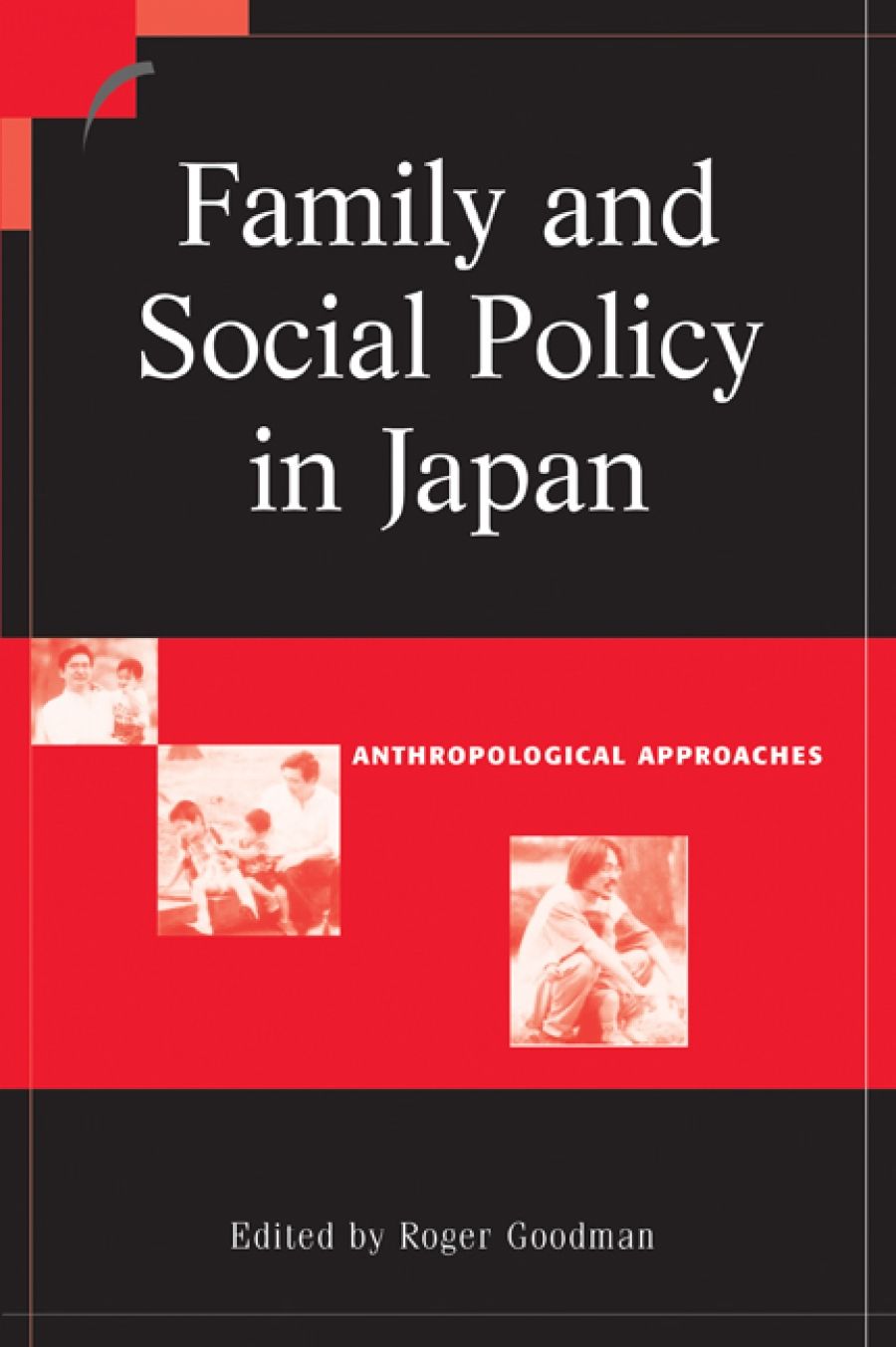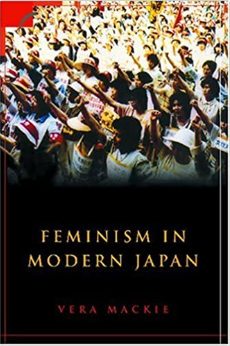
- Free Article: No
- Contents Category: Asian Studies
- Review Article: Yes
- Article Title: Ageing giant
- Online Only: No
- Custom Highlight Text:
In the latest offerings in Cambridge University Press’s ‘Contemporary Japanese Society’ series, Vera Mackie outlines 130 years of Japanese feminism, while Roger Goodman’s collection explores a decade of policy interventions in that country that challenge a society still based largely on a strict gendered division of labour. Men’s primary role is to be the overworked salaryman warrior, while women’s is to care for dependents, both children and grandparents, in a society that ‘is rapidly becoming the world’s oldest ever human population’. Perhaps the shock of 1989, when women’s birth strike reduced the fertility rate to 1.57, should have been expected.
- Book 1 Title: Family and Social Policy in Japan
- Book 1 Subtitle: Anthropological approaches
- Book 1 Biblio: Cambridge University Press, $39.95 pb, 254 pp
- Book 2 Title: Feminism in Modern Japan
- Book 2 Subtitle: Citizenship, embodiment and sexuality
- Book 2 Biblio: Cambridge University Press, $39.95 pb, 307 pp
- Book 2 Cover Small (400 x 600):
In 1945 Japanese feminists ‘were quick to react’ to the Occupation, ‘immediately’ petitioning both the Japanese government and the Supreme Command of the Allied Forces ‘on women’s political rights and for relief of the starving population’. The Constitution guaranteed equality of the sexes, marriage based on mutual consent, and the equal rights of both partners. Equal pay for equal work was introduced and a Women and Minors’ Bureau established, while women’s percentage representation in postwar Diets has not been achieved since. Radical reforms stalled when the USA positioned Japan as an ally against communism in the region. The ‘housewife became the archetypical figure of womanhood, in the same way that the salaryman became the archetypical figure of masculinity’. One strand of Japanese feminism, then, was ‘housewife feminism’, opposing pollution, dangerous consumer goods, and so on. But Japanese women’s liberation movements, like those of Western women, explored sexuality issues in radical ways and demanded women’s access to wider society. What might appear to be a ‘femocratic’ strand introduced equal opportunity legislation in 1986. Recent years have brought an Office of Gender Equality in the Prime Minister’s Department, a Plan for Gender Equality, and the inclusion of gender issues in the activities of all arms of government. Mackie notes, however, that most domestic violence shelters and suchlike are initiatives of private volunteer organisations, supported by private and local government funding.
Feminism in Modern Japan is an extensively researched and comprehensive analysis (Mackie’s own publications take up a full page in the book’s bibliography) situated in the framework of key feminist theoretical debates: concerning, for example, sameness and difference as political strategies. Mackie uses the notion of embodied citizenship to argue that the Japanese state managed male (hetero)sexuality through dichotomies that protected the chaste Japanese wife and mother from the ‘other’ woman, via licensed prostitution in the Meiji period, military prostitution (so-called ‘comfort women’) during the Pacific War, and sex tourism and the employment of immigrant sex workers in the ‘soaplands’ today. The significance of women’s embodiment is expressed, inter alia, in debates concerning sexual harassment and ongoing battles around the Eugenic Protection Law, which permitted abortions on economic grounds (and did, until 1996, have actual eugenics provisions in it).
Because the book covers such a long period of diverse activism, at times the narrative outweighs the analysis. Despite Mackie’s stated goals, the story is more about the activists of the movement than about the impact they had on Japanese gender relations, a topic that might have made for a good conclusion. One rarely gets a sense of how many women were involved in feminist actions or of how many were affected by them. I would also have liked a more explicit discussion of feminist women’s implication in Japanese imperialism, and how they recast their activities following Japan’s defeat in the Pacific War (just as the complicity of white Australian feminists in the White Australia Policy has only recently been considered, if barely understood, by mainstream Australian feminists). But these are carping criticisms. I am sure that Mackie would happily have written a longer history had her publisher allowed her to do so. Of necessity, the bones of such a full story must be stripped of much of the colour and detail that convey the immediacy and passion of feminist activism. Despite the word limits, there are many glimpses of this passionate story.
In his introduction to Family and Social Policy in Japan, Roger Goodman asserts that the chapters are ‘based on the belief that anthropology can bring a perception on [sic] policy issues that differentiates it from other disciplines’, this being ‘its ability to unpack the taken-for-granted assumptions that lie behind the production of policy’. Another theme that links the chapters is the continuing recession’s challenge to those aspects previously applauded in Japanese culture as creating the economic miracle: for example, ‘respect for seniors, the group prevailing over the individual, the importance of maintaining harmony’; and the view that mothers must be full-time parents, at least until children reach the age of three.
Glenda Roberts outlines the ‘Angel Plans’, a multi-ministry response to the precipitous decline in the birth rate, which attempt to entice more women to become mothers by expanding the role of daycare centres, creating networks for child rearing, promoting fathers’ involvement in parenting, and encouraging corporations to introduce family-friendly policies. These initiatives will come as a surprise to many Australian readers, as will the fact that only a slim majority of Japanese respondents in one survey believed that mothers should stay home when children were young.
Goodman explores the different meanings and types of child abuse in Japan, where abandonment of children by mothers is described as boshi (parent–child) shinjû (suicide), and where Western style sexual abuse and physical mistreatment appears less common, even though Japan is the source of eighty per cent of the commercial child pornography available on the Internet.
Leng Leng Thang discusses attempts to create intergenerational contact, including older villagers teaching junior school children how to plant rice to improve their skills in a dance based on rice planting, and elderly ‘hugging volunteers’ for babies in childcare centres. Other chapters cover childbirth practices, especially the plight of the increasing number of foreign wives, the detailed surveillance of children in kindergartens, funeral rituals, and normative citizenship (Mackie’s contribution).
Many of these chapters capture an economic giant as it falters and explores alternative ways for men and women to combine paid work and caring, for the Japanese to live with people of other nations and for the generations to benefit from each other. These are, as yet, very tentative moves, given the increasing gravity of the social and economic problems that confront Japan.



Comments powered by CComment